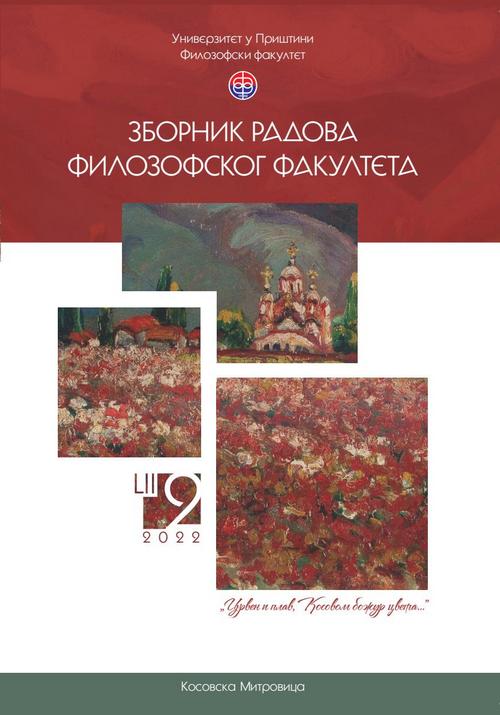Југословенско-румунско савезништво између два светска рата (Мала Антанта и Балкански споразум)
Sažetak
Стварањем Краљевине Срба, Хрвата и Словенаца након Првог светског рата нова држава је за суседа добила Краљевину Румунију. Несугласице које су постојале између двеју држава по питању разграничења у Банату решене су браком краља Александра I Карађорђевића и румунске принцезе Марије Хоенцолерн. Краљевски брак био је основа даљег развоја савезничких односа између држава у периоду између два светска рата. Партнерство је било учвршћено војно-политичким пактовима у оквирима Мале Антанте и Балканског споразума. Мировни уговори склопљени током Версајске конференције нису гарантовали сигурност „малим“ европским државама какве су биле Краљевине СХС и Румунија. Ревизионистичке тежње заједничких суседа Мађарске и Бугарске развиће пријатељске односе који су Београду и Букурешту били потребни ради одвраћања непријатеља од евентуалних акција. Југословенска јавност је на Румунију гледала као на пријатељску земљу, а дипломатске активности у оквиру двају савеза билe су са пажњом праћене од стране штампе. Поред тога, многобројни јавни радници су се бавили анализом перспектива које су у будућности могле да користе двема државама. Колико је Румунија била значајан савезник сведочи и чињеница да је децембра 1938. године посланство подигнуто на ранг амбасаде, што је била прва амбасада у дипломатској историји Краљевине Југославије. У раду намеравамо да на основу досадашњих домета историографије, као и анализе писања југословенске штампе, прикажемо развој савезничких односа између двеју држава. Посебна пажња ће бити посвећена изазовима са којима сe ово савезништво суочило за време продора Трећег Рајха на југоисток Европе. Иако савезнице, краљевине Југославија и Румунија наћи ће се на супротним странама у Другом светском рату. Међутим, између двеју држава неће доћи до међусобног сукоба што је била последица добрих односа у међуратном периоду.
Reference
Аврамовски, Ж. (1979). Југословенско-румунски односи за време Рајнске кризе 1936. године. Историјски гласник, 1–2, 135–140.
Бодрожић, М. (2001). Спољна политика Краљевине Југославије у време владавине Југословенске националне странке 1932–1934. године. Зборник Матице српске за историју, 63–64, 277–290.
Ванку, М. (1969). Мала Антанта 1920–1938. Титово Ужице: Издавачко предузеће „Димитрије Туцовић“.
Гулић, М. (2014). Краљевина Југославија и Дунав: дунавска политика југословенске краљевине 1918–1944. Београд: Институт за савремену историју.
Крофта, К. (1937). Мала Антанта, њен развој и њена важност. Летопис Матице српске, CXI, 348 (3), 225–230.
Маринковић, А. (2004). Женидба краља Александра Карађорђевића. Београд: Вајат.
Милановић, Ј. (2017). Краљица Марија Карађорђевић и Женско друштво 1922–1941. У: К. Николић (ур.), Карађорђе и његово наслеђе у српској историји (227–242). Велика Плана – Старо Село – Београд: Центар за културу Масука – Дом културе Влада Марјановић – Институт за савремену историју.
Милошевић, З. (2018). Узроци и околности који су утицали на предају источног Баната Румунији од стране Краљевине Срба, Хрвата и Словенаца (Југославије) после Првог светског рата. Национални интерес, XIV, 33 (3), 127–141.
Милошевић, М. и Јончић, Д. (2012). Јован Дучић у дипломатији. Београд: Архив Југославије.
Попи, Г. (1972). Из политичке активности Румуна у Банату после Првог светског рата. Зборник за историју, 6, 173–176.
Радовановић, М. (1937). Мала Антанта и средњоевропско питање. Летопис Матице српске, CXI, 348 (2), 190–201.
Сладек, З. (2019). Мала Антанта 1919–1938. Београд: Службени гласник.
Сретеновић, С. (2008). Француска и Краљевина Срба, Хрвата и Словенаца 1918– 1929. Београд: Институт за савремену историју.
Ћирковић, С. (1935а). Политичка и привредна Мала Антанта. Летопис Матице српске, CIX, 343 (4), 261–294.
Ћирковић, С. (1935б). Смисао и значај Пакта Балканског споразума. Осврти, 3, 19–23.
Церовић, Љ. (2000). Срби у Румунији. Темишвар: Савез Срба у Румунији.
Janjetović, Z. (2005). Deca careva, pastorčad kraljeva: nacionalne manjine u Jugoslaviji: 1918–1941. Beograd: Institut za noviju istoriju Srbije.
Krizman, B. (1975). Vanjska politika Jugoslavenske države 1918–1941. Zagreb: Školska knjiga.
Lukač, D. (1982). Т. 1: Treći rajh i zemlje jugoistočne Evrope 1933–1936. Beograd: Vojnoizdavački zavod; Balkanološki institut SANU; Prosveta; Rad.
Maran, M. (2004). Kulturni razvoj Rumuna u Banatu 1918–1941. Pančevo: Istorijski arhiv.
Petranović, B. (1988). Т. 1: Istorija Jugoslavije: 1918–1988. Beograd: Nolit.
Popi, G. (1974). Formiranje, razvoj i delovanje Rumunske stranke (1923–1929). Istraživanja, 3, 309–365.
Popi, G. (1984). Jugoslovensko-rumunski odnosi: 1918–1941. Novi Sad: Filozofski fakultet, Institut za istoriju.
Vanku, M. (2005). Srpsko-jugoslovensko-rumunski odnosi kroz vekove. Beograd: Stručna knjiga.
Vinaver, V. (1971). Jugoslavija i Mađarska: 1918–1933. Beograd: Institut za savremenu istoriju.
Detalji u vezi sa uređivačkom politikom, uključujući i autorska prava, dostupni su na sajtu SCIndeks.
http://scindeks.ceon.rs/journalDetails.aspx?issn=0354-3293

